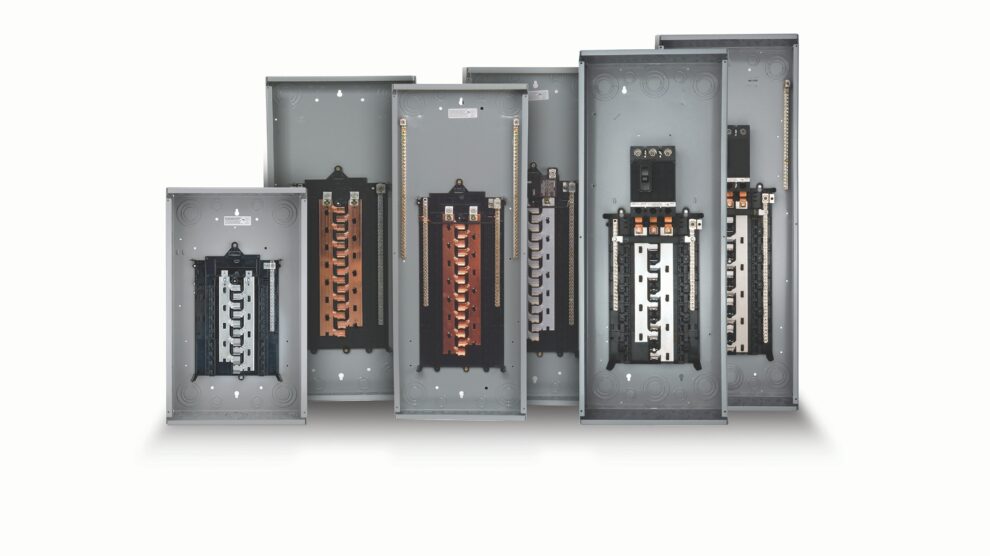What Are The Fundamentals Of Load Centers?
Every home and building uses electric power for appliance loads, receptacles, and lighting. Light commercial and residential applications use a load center to distribute power delivered by the utility provider throughout the building or home to supply it all the branch circuits. The load center’s circuit breaker safeguards every branch circuit.
Suppose there is a power overload on a circuit or a short circuit. In that case, the circuit breaker will stop power flow before any personal injury or property damage can happen. Load centers are tested, designed, and made according to the newest applicable standards, such as:
- NEC (National Electrical Code)
- NEMA (National Electrical Manufacturers Association)
- CSA (Canadian Standards Association)
- UL (Underwriters Laboratories)
Difference Between A Panelboard And Load Center
A load center is similar to a panelboard in offering power distribution features. As per NEC and UL standards, the two units don’t have any difference. The electrical sector in North America utilizes the lower-cost, smaller panelboards used in residential solutions as load centers. Typically, panelboards are deeper compared to load centers and can take both plug-on and bolt-on circuit breakers, while a load center utilizes only plug-on breakers.
Purpose Of Load Centers
A load center protects maintenance staff and homeowners by placing all branch circuits in a single enclosure, enabling users to avoid contact with powered electrical parts. It leverages plug-on circuit breakers to dependably distribute power to circuits in a small building or home. The term plug-on indicates how the circuit breaker links to the load center’s bus bar. A load center uses electronic or specialty circuit breakers to offer protection from arc and ground faults.
There are different names for load centers, including distribution panel, panelboard, breaker box, and fuse box. Historically, residences leveraged fuse panels for power distribution, but of late, the industry standard is load centers with hosted circuit breakers.
Uses Of Load Centers
Load centers are utilized in various applications, including in OEM (original equipment) products and single-family units.
OEM (Original Equipment)
Machinery OEMs utilize load centers to distribute electricity in their power systems.
Renovation
Load centers can be leveraged to replace and upgrade older distribution solutions.
Light Commercial
Load centers distribute power in commercial buildings like warehouses, office buildings, and strip malls.
Multi-Family Residential
Townhomes, condos, and apartments commonly use load centers for power distribution. They are typically deployed inside group metering devices.
Single Family Residential
Homes typically use one or multiple load centers for power distribution. They are commonly placed outdoors or in the basement or garage, depending on the house layout.
Installation Of Load Centers
Load centers can be installed in multiple ways, which included the following:
Main Breaker Or Service Entrance Panel
- The power entry point of the building or home
- Only one service entrance panel can be placed per building or home
- Ground and neutral can be connected together
Main Lug Or Sub Panel Only
- Utilized in the downstream of the service entrance panel
- Useful when including added electrical services to a building or home
- Powered from the service entrance panel’s branch circuit
- Dedicated ground bar and insulated and isolated neutral bar are needed
Flush Mounted
- Kept between studs in a wall for space-saving
Surface Mounted
- Mounted on the wall surface
- Applied in garages, basements, or buildings
Difference Between Main Circuit Breaker And Main Lug Only (MLO) Load Center
A load center can be built with either MLO or main breaker design. In the main breaker build, the supply cables are directly connected to the main breaker, which offers an overcurrent shield for all branch circuits. Besides, it also presents one disconnect method for all loads fed by the load center.
MLO load centers are generally applied at a main breaker panel’s downstream and are termed sub-panel. In MLO load centers, there is the termination of incoming cables on the lugs’ line side, which are directly attached to the bus. The panel on its own does not have any main overcurrent device.
We advise you to get in touch with a reliable vendor to get good recommendations for the ideal electrical systems and devices for your home or business needs. Doing so ensures you get expert advice and guidance for selecting the best of electrical solutions!







Add Comment